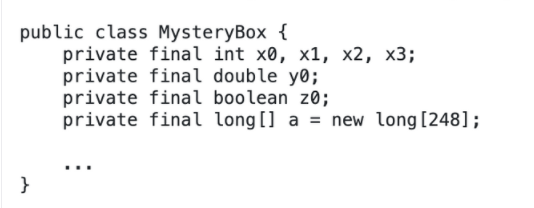Consider the following definition of a MysteryBox object: public class MysteryBox { private final int x0, x1, x2, x3; private final double y0; private final boolean z0; private final long[] a = new long [248]; ... } Using the 64-bit memory cost model from lecture, how many bytes does each object of type MysteryBox consume? Include all memory referenced by the object (deep memory).
Consider the following definition of a MysteryBox object: public class MysteryBox { private final int x0, x1, x2, x3; private final double y0; private final boolean z0; private final long[] a = new long [248]; ... } Using the 64-bit memory cost model from lecture, how many bytes does each object of type MysteryBox consume? Include all memory referenced by the object (deep memory).
Database System Concepts
7th Edition
ISBN:9780078022159
Author:Abraham Silberschatz Professor, Henry F. Korth, S. Sudarshan
Publisher:Abraham Silberschatz Professor, Henry F. Korth, S. Sudarshan
Chapter1: Introduction
Section: Chapter Questions
Problem 1PE
Related questions
Question
![Question
Consider the following definition of a MysteryBox object:
public class MysteryBox {
private final int x0, x1, x2, x3;
private final double y0;
private final boolean z0;
private final long[] a = new long [248];
}
Using the 64-bit memory cost model from lecture, how many bytes does each object
of type MysteryBox consume? Include all memory referenced by the object (deep memory).
Answer
Your answer should be a positive integer that is a multiple of 8.](/v2/_next/image?url=https%3A%2F%2Fcontent.bartleby.com%2Fqna-images%2Fquestion%2F88167701-6d3f-46b8-9f75-5ab21a2347bf%2F0d97c698-ab72-457c-85e4-ead1cff468e6%2F9uduojo_processed.png&w=3840&q=75)
Transcribed Image Text:Question
Consider the following definition of a MysteryBox object:
public class MysteryBox {
private final int x0, x1, x2, x3;
private final double y0;
private final boolean z0;
private final long[] a = new long [248];
}
Using the 64-bit memory cost model from lecture, how many bytes does each object
of type MysteryBox consume? Include all memory referenced by the object (deep memory).
Answer
Your answer should be a positive integer that is a multiple of 8.
![Question
Which of the following parent [] array(s) could be the result of running
the weighted quick-union algorithm on a set of 10 items?
Recall that our weighted quick-union algorithm uses union by size (number of nodes),
not union by height.
Answer
Mark all that apply.
O0 22 3 4 5 6 7 3 2
5855512 4 2 5
0011911161
U42211 6 2 4 8 7
00397000 9 0](/v2/_next/image?url=https%3A%2F%2Fcontent.bartleby.com%2Fqna-images%2Fquestion%2F88167701-6d3f-46b8-9f75-5ab21a2347bf%2F0d97c698-ab72-457c-85e4-ead1cff468e6%2Fkk4114i_processed.png&w=3840&q=75)
Transcribed Image Text:Question
Which of the following parent [] array(s) could be the result of running
the weighted quick-union algorithm on a set of 10 items?
Recall that our weighted quick-union algorithm uses union by size (number of nodes),
not union by height.
Answer
Mark all that apply.
O0 22 3 4 5 6 7 3 2
5855512 4 2 5
0011911161
U42211 6 2 4 8 7
00397000 9 0
Expert Solution
Step 1
Solution:
i)
Given,

Trending now
This is a popular solution!
Step by step
Solved in 4 steps with 2 images

Recommended textbooks for you

Database System Concepts
Computer Science
ISBN:
9780078022159
Author:
Abraham Silberschatz Professor, Henry F. Korth, S. Sudarshan
Publisher:
McGraw-Hill Education

Starting Out with Python (4th Edition)
Computer Science
ISBN:
9780134444321
Author:
Tony Gaddis
Publisher:
PEARSON

Digital Fundamentals (11th Edition)
Computer Science
ISBN:
9780132737968
Author:
Thomas L. Floyd
Publisher:
PEARSON

Database System Concepts
Computer Science
ISBN:
9780078022159
Author:
Abraham Silberschatz Professor, Henry F. Korth, S. Sudarshan
Publisher:
McGraw-Hill Education

Starting Out with Python (4th Edition)
Computer Science
ISBN:
9780134444321
Author:
Tony Gaddis
Publisher:
PEARSON

Digital Fundamentals (11th Edition)
Computer Science
ISBN:
9780132737968
Author:
Thomas L. Floyd
Publisher:
PEARSON

C How to Program (8th Edition)
Computer Science
ISBN:
9780133976892
Author:
Paul J. Deitel, Harvey Deitel
Publisher:
PEARSON

Database Systems: Design, Implementation, & Manag…
Computer Science
ISBN:
9781337627900
Author:
Carlos Coronel, Steven Morris
Publisher:
Cengage Learning

Programmable Logic Controllers
Computer Science
ISBN:
9780073373843
Author:
Frank D. Petruzella
Publisher:
McGraw-Hill Education